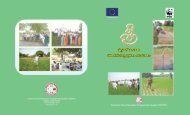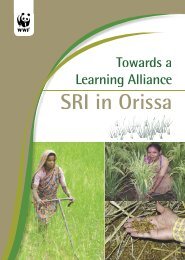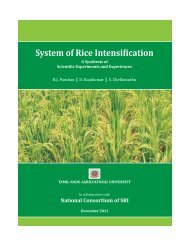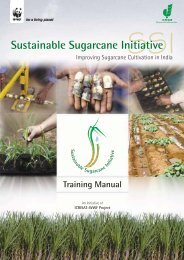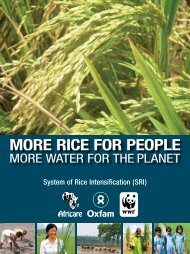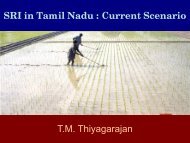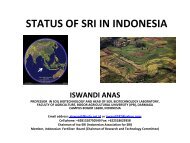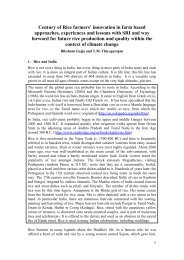SSI Newsletter - SRI - India
SSI Newsletter - SRI - India
SSI Newsletter - SRI - India
Create successful ePaper yourself
Turn your PDF publications into a flip-book with our unique Google optimized e-Paper software.
The following article was written by Frank A. Hilario and is a detailed analysis of the present world<br />
situation of sugarcane and sugar industry and how well the <strong>SSI</strong> Manual of ICRISAT-WWF can come to<br />
the rescue of the resources strapped farmers. It has been reproduced here with his kind permission.<br />
Sweet Revolution, 2009! <strong>SSI</strong> gives birth to Neo-Agriculture<br />
Frank A. Hilario<br />
May 27, 2009<br />
Revised 29 May 2009<br />
at 0949 Manila time<br />
SWEET LOVE C12H22O11, Sweet Ignore<br />
C7H5NO3S. Quite simply, I like my<br />
sugar naturally sweet, not artificially<br />
saccharine. I like it harvested from<br />
the field rather than from the lab;<br />
I like it cultured on soil rather than<br />
cultured on Petri dishes or whatever. I<br />
want to be in the US, the home of the<br />
brave and the land of the free. But I<br />
don’t want to be sugar-free.<br />
I’m in the Philippines; I am a farmer’s<br />
son; I am part of the island – I prefer<br />
the natural to the man-made. Today,<br />
I want to talk nicely about sweetness.<br />
Grown by mild-mannered chemists<br />
in immaculate facilities, C7H5NO3S,<br />
Saccharin is sweet; grown by toughtalking<br />
farmers on uneven farms with<br />
hard methods, C12H22O11, sugar is<br />
sweet and delectable.<br />
And that would be muscovado. In the<br />
late 1940s to early 1950s, as a boy in<br />
shorts going to grade school in the<br />
village of Sanchez in the sleepy town of<br />
Asingan, Pangasinan in Central Luzon<br />
in the Philippines, I had muscovado<br />
in my pocket somewhere to bring<br />
out as snack. Were we poor? Not<br />
really, but I have always been a sweet<br />
tooth; I loved the brown color and<br />
the God-given sweetness. Asingan<br />
never had a sugarcane plantation,<br />
but we always had muscovado. It<br />
must have come from Tarlac, from<br />
the Central Azucarera De Tarlac, the<br />
sugar refinery of the Cojuangcos, who<br />
own Hacienda Luisita, all of 5,000<br />
hectares, reportedly the Philippines’<br />
largest sugarcane plantation<br />
(manilastandardtoday.com) – Tarlac<br />
Province is next to Pangasinan. I<br />
preferred the light one ‘with a warm<br />
honey color and creamy fudge flavor’<br />
(billingston.co.uk). Today, raw sugar,<br />
muscovado is considered a health<br />
food. Not surprisingly, it has all<br />
the natural vitamins & minerals in<br />
sugarcane juice (sugarindia.com). I<br />
love it!<br />
Raw sugar is a major export of the<br />
Philippines. For 2009, the country will<br />
supply 13% of the total volume the US<br />
is importing for the year (March 2009,<br />
agriculture-ph.com). How sweet!<br />
We Filipinos are good in raising Cain,<br />
that’s for sure. If you didn’t know, you<br />
have not been reading the papers.<br />
Now, are we Filipinos good in raising<br />
cane? Definitely not! That’s why I’m<br />
writing this long essay. But we are<br />
good producers of sugar. In crop year<br />
2002-2003, total sugar production<br />
in the country increased by 32.6%<br />
compared to 1998-1999 largely due<br />
to higher sugar recovery by 22%;<br />
the increase can also be attributed<br />
to ‘favorable climatic conditions,<br />
adoption of high-yielding varieties,<br />
improved cultural practices, increased<br />
farm inputs, and better milling<br />
facilities’ (Asia Pulse, August 2003,<br />
goliath.ecnext.com). (I tried hard but<br />
I couldn’t get 2007 or 2008 data on<br />
recovery rate.)<br />
The problem there is that ‘favorable<br />
climatic conditions’ doesn’t apply<br />
anymore; cultural practices need to<br />
be much improved still – and farm<br />
inputs need to be decreased. Our<br />
technical knowledge needs to change<br />
for the better, and not only in making<br />
things clear to the layman.<br />
We Filipinos learned to produce sugar<br />
in Luzon for export in the 1830s<br />
(Michael S Billig, 2003, cited in World<br />
Sugar History <strong>Newsletter</strong> July 2004).<br />
Today, some 170 years later, the way<br />
we grow sugarcane leaves much to<br />
be desired.<br />
Actually, the world over, most<br />
sugarcane farmers have much to<br />
learn about raising cane. We need<br />
a Sweet Revolution in sugarcane<br />
farming in response to the realities<br />
of climate change (global warming/<br />
global cooling), inefficient practices<br />
(like too much fertilizer), and<br />
dwindling resources (like the water<br />
table going down – our water deposits<br />
are overdrawn).<br />
For sugarcane farmers in the dry<br />
tropics, who can they turn to, to<br />
learn to grow sugarcane much, much<br />
better? The Brazilians are the biggest<br />
sugarcane producers in the world,<br />
but Brazil doesn’t have the drylands<br />
that we have. In the 2007-2008<br />
season, total sugarcane production<br />
was estimated highest in Brazil at 491<br />
M tonnes, followed by <strong>India</strong> at 348 M<br />
tonnes (commodityonline.com). So<br />
Sustainable Sugarcane Initiative<br />
<strong>SSI</strong> is<br />
sugarcane<br />
agriculture<br />
at its best.<br />
Nov ‘09<br />
7<br />
SugarCane<br />
matters



